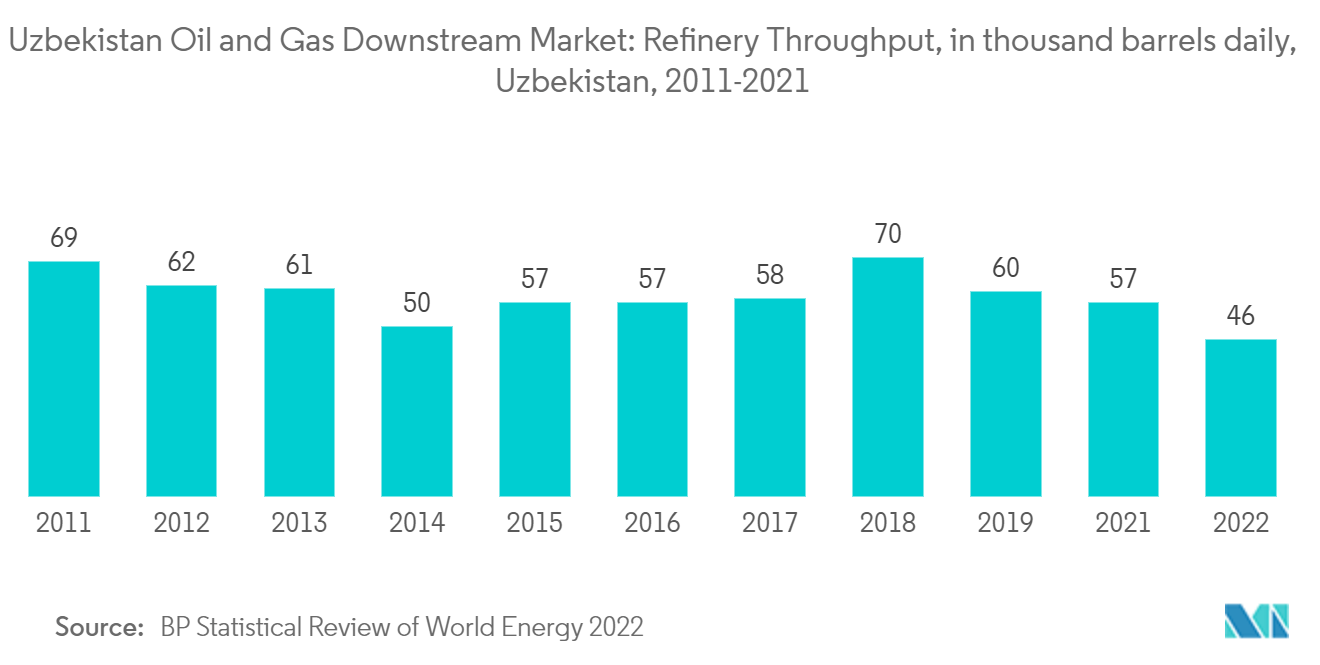Market Trends of Uzbekistan Oil and Gas Downstream Industry
This section covers the major market trends shaping the Uzbekistan Oil & Gas Downstream Market according to our research experts:
Refineries to Dominate the Market
- The refineries sector has dominated the Uzbekistan Oil and Gas Downstream Market in recent years and is expected to continue to do so during the forecast period.
- The country has only three refineries under operation, the Alty-Aryk NPZ, Ferghana NPZ, and Bukhara NPZ Refinery. All three refineries in the country are in dire need of expansion and modernization. The country's refinery throughput reached 46 thousand barrels per day in 2021.
- The country is actively trying to ramp up its downstream oil and gas sector through a series of investments in the modernization and expansion of its existing refineries.
- The country has extensive hydrocarbon reserves: according to local industry officials, the country's total primary energy reserves (proven and projected) exceed 5.5 billion tons of oil equivalent (TOE), including 1.5-1.6 billion tons of natural gas and 245 million tons of oil.
- As the second largest natural gas producer in Central Asia in 2021, Uzbekistan produced 53.6 billion cubic meters of natural gas and plans to make 66.1 billion cubic meters by 2030, of which 56.5 billion will be used on the domestic market.
- In June 2022, Sanoat Energetika Guruhi LLC (SEG), a Uzbekistan oil and gas company, acquired the formerly state-owned Fergana Oil Refinery LLC (Fergana); the acquisition followed a competitive tender process as part of Uzbekistan's state asset privatization program. Following the acquisition, the company plans to modernize the Fergana Oil Refinery and double its capacity to two million tons annually. By September 2023, the refinery will produce Euro-5 gasoline and various modern types of oils and other refined products.
- In December 2021, The Hyundai Engineering Company announced the completion of a GTL (Gas-to-Liquid) plant in Uzbekistan worth USD 2.62 billion. 'GTL' refers to a method for chemically reacting natural gas to produce liquid petroleum products.
- Owing to several major upcoming projects for capacity expansion and capacity addition, the refineries sector is expected to dominate the market due to forthcoming projects of development and construction of new refineries.

Demand for Petroleum Products to Drive the Market.
- Uzbekistan is a major producer of natural gas, just like its neighbors Kazakhstan and Turkmenistan. The country plans to increase production, but instead of exporting gas as raw material, investments have been made in processing capacities to meet the increasing demand for fuel, plastics, and other products by the country's growing population and industrial sector.
- The struggles of Uzbek drivers in finding petrol or diesel for their cars have been the most obvious manifestation of this phenomenon for the past two decades. In recent years, cars have switched en masse to run on compressed natural gas (CNG) instead, with filling stations advertising 'metan' (compressed gas), which is now used by nearly two-thirds of vehicles. The local automotive industry has now produced cars that are designed to run on this fuel, whereas motorists initially converted their own cars.
- As part of Uzbekistan's goal to move away from natural gas exports and to produce higher-value products domestically, the first synthetic diesel was produced at the newly built gas-to-liquids (GTL) plant UzGTL (UzGTL) in July 2022. By the time the plant is fully operational, it will produce over 1.5mn tonnes per year of finished liquid fuel products, including 307,000 tpy of jet fuel, 724,000 tpy of diesel fuel, 437,000 tpy of naphtha and 53,000 tpy of liquefied gas.
- According to Uzbekistan's Energy Minister, the country wants to expand its capacity for deep processing domestic natural gas; decrease the imports of hydrocarbons; satisfy local requirements for high-quality, environmentally friendly fuel; and provide strategic value-added products based on its own raw materials to the market. The crude oil consumption in the country reached 90 thousand barrels per day in 2021 from 82 thousand barrels oer day in 2014.
- The head of the downstream department of the state oil and gas company Uzbekneftegaz stated that Uzbekistan is interested in investing in petrochemical projects such as GTL or methanol-to-olefins (MTO).
- In November 2021, Uzbekistan has announced a new gas-chemical project that will be based on MTO technology. The USD 2.5 billion project will begin operations in the fourth quarter of 2023 and will provide the country's domestic industry with olefinic hydrocarbons.
- In view of these factors, the ongoing investments and developments in petrochemical sector in the country is expected to dominate the market during the forecast period.


